It’s no secret that math isn’t my strongest subject, but lately I have come across a few math books that I really love!
The reason? They’re less about the numbers and more about concepts and story – that’s my kind of math book. This kind of critical thinking and the ability to look at things from different perspectives is beneficial in all subject areas!
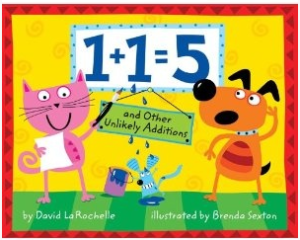 1+1=5 (And other Unlikely Additions)
1+1=5 (And other Unlikely Additions)
Amazon says this book is a “joyful mathematical journey” and I agree! These unlikely additions are more like brain teasers and help students use a whole bunch of thinking/reading skills to exercise their brains in creative ways.
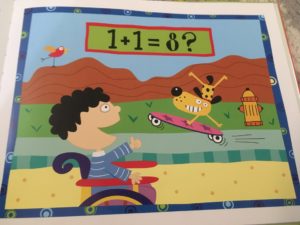 The pictures in this book could easily be used as quantitative pictures, which is just a fancy way to say pictures with lots of things to count. In addition to providing solid counting practice, quantitative pictures can start mathematical conversations that will help younger students start thinking about the world around them in a mathematical way. Read more about that at SIS4Teachers.org.
The pictures in this book could easily be used as quantitative pictures, which is just a fancy way to say pictures with lots of things to count. In addition to providing solid counting practice, quantitative pictures can start mathematical conversations that will help younger students start thinking about the world around them in a mathematical way. Read more about that at SIS4Teachers.org.
The book is laid out very well for students to be able to make predictions based on the pictures. The left-hand side of the spread presents “an unlikely addition.” Of course, primary students will notice that the problem is not correct! First, remind students that the problem doesn’t give any units and the units are what will make the problem work. Prompt students to look for things in the picture that might add up to the total – yes, there is 1 skateboard, but it has 4 wheels, so maybe that 1 is actually worth 4!
It would be fun to have one of these on the board for students to study as a bellringer, or in a station for students to think about collaboratively. Multiple perspectives are often helpful for solving problems like this!
Once students get the concept of playing with quantities, they can make their own quirky math equations. Provide a picture and have students all come up with different problems, or have students work in groups to create a page that they can trade with another group to solve. Emulate the digital artwork in this book by using a graphics tool like Canva!
This cute little story has a plot and characters (and also a surprise ending) so it works for traditional fiction activities and reading aloud, but it is also a counting book and uses nonstandard units of measurement and relative size. So many possibilities!
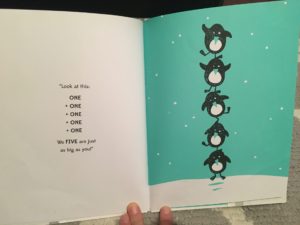
Counting is the first choice here. The quantities go through 6, at which point the bear, being a little hungry, loses patience with his fellow arctic creatures trying to say to prove they are as big as he is. Each page adds one more animal to the stack, and in the text, it shows counting by ones to reach the total.
Since you probably don’t have penguins, foxes or polar bears laying around, this would be a good opportunity to use some concrete manipulatives to act out the story. Have students count out 1″ cubes or counters as they read to see how many animals the page is showing. Depending on your reading situation, students could also put a counter on each animal in the picture to help solidify the quantity.
This might be a fun story to introduce nonstandard units of measure and get students thinking about how objects relate to each other in size. They could also start thinking about how we could measure differently “That bear is 6 penguins tall!” This would be a good transition to questions like “How many paperclips long is the pencil?” which students could then figure out.
Have students try their hand at writing a story like this! All these “units of measure” are animals in the same habitat. What else could we use? Maybe a different habitat (what kinds of animals live in the desert – there’s a science/social studies connection too!)? School supplies (math manipulatives, art supplies, books, furniture, etc.)? Students (How many Connors tall is Mrs. Mac)?
Popplet is a great simple tech tool that students can use to document their measurements. Take a picture of an object and place it in the middle of the Popplet, then students can add pictures showing how many other items are the same size as that object.
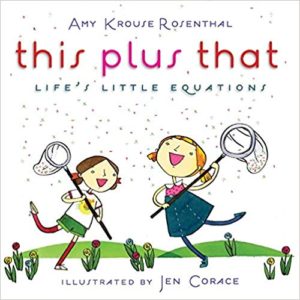 This Plus That: Life’s Little Equations
This Plus That: Life’s Little Equations
Amy Krouse Rosenthal is just one of those solid authors – I know that anything that has her name on it is going to be awesome!
While this book is about equations, there are no numbers in here at all! It’s like algebra! This book is full of ideas and places and situations and breaks them down into smaller conceptual components – at its core, what is it made up of? For example ; wishes + frosting = birthday
The book covers everything from celebrations to seasons to colors to music and art, and offers so many opportunities for thought and discussion.
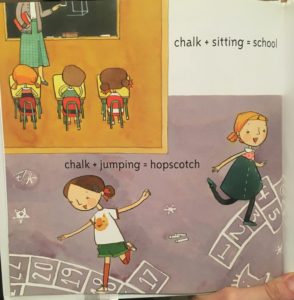 Discuss the idea of variables. In one situation, an object means one thing, in another it can be completely different depending on what else is around it. Chalk means something different in school than it does on the playground. What elements of various equations (in the book, in life, in math) do we need to change to make the equation true? Which variables can we change? Which variables are fixed?
Discuss the idea of variables. In one situation, an object means one thing, in another it can be completely different depending on what else is around it. Chalk means something different in school than it does on the playground. What elements of various equations (in the book, in life, in math) do we need to change to make the equation true? Which variables can we change? Which variables are fixed?
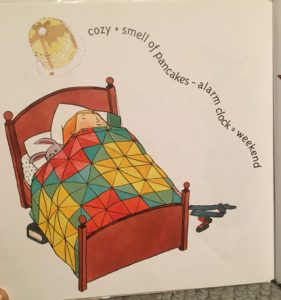
Writers’ Workshop – take that situation/place/experience and break it into smaller parts. Is it an addition problem? Division? Multi operational? What are the components of that moment? Each component can be a paragraph or a sentence and, together, it can add up to a whole essay or paragraph.
Bell Ringer/Brain Teaser – put up the equation on the board – have students guess what the answer will be. It could be different answers depending on students’ experiences and background knowledge, which could make for some great conversation or writing prompts!
What is your favorite math mentor text?

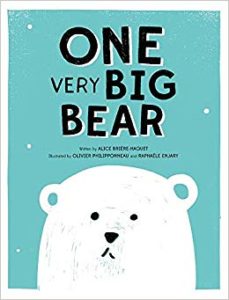





Leave a Reply